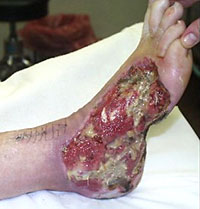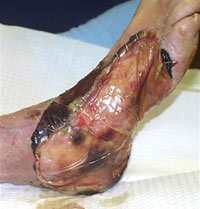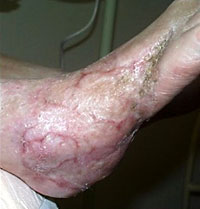
|
A 67-year-old woman developed
foot necrosis due to complications of atherosclerosis.
The foot was managed by basic topical care and debridement.
Operative revascularization was done (saphenous
vein graft to dorsalis pedis artery), and the wound
responded with rapid proliferation of granulation
tissue. After that, even skin grafts would have
healed readily on the simple areas, but complex
areas of exposed bones, joints, tendons, and ligaments
complicated the coverage issues. Flaps are conventionally
needed, local or free, but in an arteriopathic foot
wound of this size, they are either not available
or have too many potential risks. Integra provides
a wound management option for difficult wounds.
|
 |
|
The wound was debrided and closed
with Integra, shown here 6 weeks after placement
and ready for skin grafts.
|
 |
|
The foot healed and remained
stable, seen here 6 months later.
|
 |
Cases Courtesy of:
Marc E. Gottlieb, M.D., Jennifer Furman
Journal of Burns and Wounds, Vol 3, #2